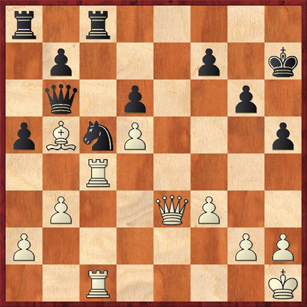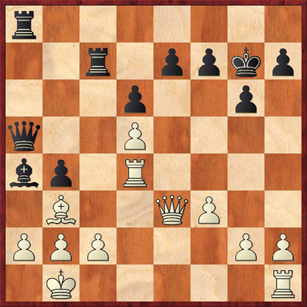In one of my very first posts in this blog, I profiled a Bay Area youngster named Erik Kislik, who at that time was an expert with a rating about the same as mine (2115). I described him as being an incipient chess hobo — a person who cares only about chess, who studies chess for hours a day at school instead of studying for his classes, and who is very willing to travel to tournaments with no set itinerary. (The way I met him was that he asked me for a ride back home from the Western States Open in Reno.)
Well, I haven’t really heard anything about Erik Kislik for the last two years, but earlier this week a reader of this blog e-mailed me and asked if I was aware that he was playing earlier this month in Hungary! Well, I can’t say that I am surprised. If you asked me for a list of “most likely American chess players to turn up in Hungary,” Erik would have to be on the list. He has apparently been busy over the last two years: his rating has gone up 200 points to (FIDE) 2339, and he has earned himself a FIDE Master title.
Why go to Hungary? Well, it’s sort of a mecca of chess. They have a monthly tournament called “First Saturday,” where every month qualified players can come and compete for GM or IM norms. Even though there is no prize money (!!), they still attract title-hungry players from all over the world. As ChessLecture subscibers may know, Bill Paschall is one of them — he went to Hungary and liked it so much that he stayed! So Erik is following in distinguished footsteps.
I suspect Erik is rather disappointed with his results in the September First Saturday tournament. He started out on fire, winning his first two games against 2400 players and drawing the next two. As I’ll show below, he should have won in round four, which would have given him a terrific 3.5-0.5 start, with only 5 points (out of 9) needed for an IM norm. Unfortunately, it all went downhill from there. He didn’t win any more games, and lost his last two to finish with 4 points. No norm. But nevertheless, some interesting chess, as I’ll show you.
In round one, Erik got lucky.
In this position, as White against a player named Reiner Odendahl, he played 31. Rf4?, offering a bishop sacrifice that Black cannot afford to take. However, he has overlooked a tactical shot. Can you tell what it is?
First I’ll tell you how the game finished. Odendahl missed the tactical shot, too, and played 31. … Rf8. The game continued 32. Bc4 Rac8 33. g4 and White got a ferocious attack. After 33. … Nd7 34. Qe7 Ne5 35. gh g5 36. Qxg5 Rg8 Black resigned without waiting for 37. Bd3+, which forces checkmate.
When I saw the position after 31. Rf4, the move that immediately came to my mind was 31. … Nd3. This is a heck of a move. It has just about everything: two simultaneous discovered attacks, a fork, a queen sac, and a threat of a back-rank mate. Of course the point is that after either 32. Qxb5? or 32. Qxd3? Black wins with 32. … Rxc1+ followed by mate. But the problem is that White has a desperado defense: 32. Rxf7+! Kg8 33. Rf8+! The rook gives itself up in order to either deflect Black’s rook or to allow White’s queen to penetrate with check after 33. … Kxf8 34. Qh6+. The computer says that White draws here after 34. … Kf7 35. Bxd3, although I would want to look at it carefully before I agree with that assessment.
Anyway, the correct solution undoubtedly is 31. … Ne4!! This move makes almost exactly the same threats as 31. … Nd3, but it has the additional subtle point that it blocks the e-file. Therefore after 32. Rxf7+ Kg8 33. Rf8+ Black can decline the desperado rook and play 33. … Kg7! White’s only hope is to continue the desperado checks with 34. Rf7+, but now Black can take with 34. … Kxf7, and White’s only check is the ineffective 35. Qf4+, which is easily defended by 35. … Nf6.
There are two great lessons to be learned from this example. One is the idea of desperadoes, and the other is the old saying: “If you see a good move (31. … Nd3) look for a better one (31. … Ne4!!).”
Our second example is from round four, where Erik missed his chance to get to a “plus-three” score.
This time Erik was Black in a Dragon Sicilian, and the question is whether Black has anything better than simply ratcheting up the pressure with 20. … Bxb3 21. Qxb3 R7a7, which should win back the pawn but doesn’t really seem to lead to any advantage for Black after 22. Kc1.
Instead, Erik correctly offers a beautiful rook sacrifice:
20. … Rc3!!
This is a common enough theme in the Sicilian Defense, but usually Black captures a knight on this square. Here, he’s just offering his rook for free!
Clearly White cannot decline the sacrifice. The point is that Black’s rook disrupts the communication between White’s queen and bishop, so that if the queen moves away, 21. … Bxb3 will now be a smashing move. Likewise, if 21. bc, Bxb3! demolishes White’s position and allows the Black queen and rook to invade, with a possible continuation being 22. cb Qxa2+ 23. Kc1 Qa1+ 24. Kd2 Ra2+ 25. Kd3 Qxc3+ 26. Ke4 f5+ 27. Kf4 g5+! winning White’s queen.
Erik’s opponent, a grandmaster named Attila Czebe, saw all this and put up stiffer resistance with 21. Qxc3! bc 22. Rxa4 Qd8 23. Rxa8 Qxa8 24. bc, which reaches a position with queen versus rook and bishop. However, White has too many weaknesses, and Erik eventually got to the following position:
Here Erik opted to repeat the position with 36. … Qd7 37. Rb7 Qa4 38. Rb3, and the game was drawn. I have to think that the clock must have had something to do with this decision (time control was 40 moves in 90 minutes, plus a 30-second increment). According to Fritz, Black is still winning after 36. … Qa5, and if 37. Ra3 Qb6+ followed by 38. … Qa7. White does not have a good way to break the blockade; Black can even retreat to a8 if necessary and White can never break through. Meanwhile, Black’s kingside pawns should be decisive, or close to it. (In some lines Black sacrifices his pawn on h3 to pull White’s bishop away and enable him to take the pawn on a6. Again, some careful analysis is needed — which I haven’t done yet — to determine whether Black is really winning there or whether the computer’s assessment of a winning advantage is an optical illusion.)
All of this is very easy for us to say after the fact, with a computer chess engine helping us out. In the heat of a tournament, with a grandmaster sitting across the board from him and his clock ticking down, it’s easy to understand why Erik opted for the safe draw.
I guess the moral of our second example is: It’s tough to beat a grandmaster!






{ 2 comments… read them below or add one }
After reading Kerouac’s “Dharma Bums” many years ago, I was inspired to begin writing a novel I called “Chess Bums” that imagined someone like Erik and a loose collection of chess friends making their way across the country and then to Europe following their “religion.” It really didn’t go anywhere, but I still prefer “Chess Bum” to “Chess Hobo.”
Interesting story…I believe this was the kid you mentioned who only studied books written by GMs? Pretty inspiring!
{ 1 trackback }